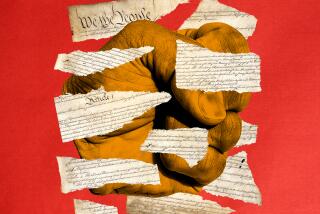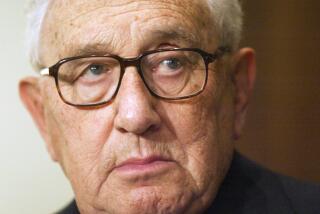Perspectives on the fall of the Berlin Wall
- Share via
We make fun of Nostradamus and numerologists, but give editors an anniversary and the floodgates open. We’re anniversary-ologists, as USA Today might say. Unfortunately, trying to take the pulse of what happened in Eastern Europe in 1989 is more complex than counting back the years. Just as 1865 or 1945 can’t be explained without 1787 or 1933, so 1989 -- the year communism either imploded or didn’t, the world either changed or didn’t and history either ended or kept going -- poses challenges.
One can take the “I was there” approach of Michael Meyer, Newsweek’s bureau chief for Germany, Central Europe and the Balkans between 1988 and 1992, in his book “The Year That Changed the World: The Untold Story Behind the Fall of the Berlin Wall.” Meyer places the spotlight on what happened -- Hungary’s opening of its borders, the Nov. 9 fall of the Berlin Wall, the domino decline of other Eastern European states -- while lacing in accessibly deep, if not Hegelian, historical explanation.
Another tack is the “if you knew what I know” analysis offered in Princeton historian Stephen Kotkin’s “Uncivil Society: 1989 and the Implosion of the Communist Establishment,” which frames the story as badly told rather than untold: a fantasy of people power sweeping Europe that’s better dissected nation-by-nation, with insight into doomed governments and failed systems.
The foreign-accented version of this -- “if you knew what we Europeans know, going back a century” -- is represented by “There Is No Freedom Without Bread!: 1989 and the Civil War That Brought Down Communism,” courtesy of ex-Soviet academician and Mount Holyoke scholar Constantine Pleshakov. It traces Eastern European history in such detail that even David Hume might be convinced that mists of causal determinism hovered over the Danube, Vistula and other key rivers in the late 1980s.
Finally, there’s the “multi-voiced mulling” of Texas A&M professor Jeffrey A. Engel’s “The Fall of the Berlin Wall: The Revolutionary Legacy of 1989,” which gathers papers from a symposium at the university’s Scowcroft Institute of International Affairs.
How to make sense of all these overarching syntheses? The best way to start is to refresh one’s memory of the year’s events, then size up the clichés that emerged from them.
From February to April 1989, Poland’s communist government, after years of wrestling with a Solidarity-led civil society, held round-table negotiations with the opposition. The result was a landslide Solidarity victory in June elections and a Solidarity prime minister by August.
On June 27, Hungary cut down the barbed wire on its Austrian border, allowing thousands of East Germans to begin a mass exodus to the West. Throughout the year, Soviet president Mikhail Gorbachev publicly and privately repudiated the “Brezhnev Doctrine,” his nation’s commitment to keep Eastern European states communist by force, if necessary. He also strategized, Kotkin writes, “to prevent Eastern European regimes from cracking down themselves.”
On Oct. 9, a mass protest of some 70,000 in Leipzig elicited a weak response from the East German government, emboldening further protests. On Oct. 18, East Germany’s Communist Party “retired” its longtime hard-line leader, Erich Honecker, who had once declared, “We took power in order to hold it forever.”
By Oct. 23, 250,000 East Germans were marching in Leipzig. On Nov. 9, after East German spokesman Günter Schabowski ineptly and incorrectly answered a reporter’s question by stating that a new freedom-to-travel policy was operative immediately, thousands headed to the Berlin Wall, which then peaceably “fell.” But bloodshed would still follow in Romania. In December, Romanian president Nicolae Ceausescu ordered his troops to fire on demonstrators in Timisoara, triggering a series of violent events (1,104 Romanians were killed, according to official statistics) that led to the trial and execution of Ceausescu and his wife on Dec. 25.
For perspective, it’s worth remembering that Germany didn’t reunite until the following year. The Soviet Union’s dissolution came only at the end of 1991. And China’s Communist leaders, mindful of events in Eastern Europe, brutally cracked down on the Tiananmen Square street protests in June 1989, killing hundreds or thousands to keep alive the regime that persists today.
Still, short-term judgments on 1989, at least in the West, were triumphalist. Liberal democracy and capitalism defeated communism. People power defeated dictatorship. Among the stated causes were Gorbachev’s commitment to glasnost and perestroika and rejection of force; globalization’s opening of Western prosperity to Eastern eyes; the bravery of reform Communists in Hungary; a vibrant Polish civil society, further galvanized by a Polish pope; Ronald Reagan’s tough-guy tactics; and fear of a Tiananmen-type massacre in Europe.
All four of the books here echo or massage most of these reasons while opposing the simplistic notion that democracy-inspired people power, or U.S. foreign policy under the Reagan administration, defeated communism in a one-year knockout. Meyer, predictably the most conversational of these authors, admits that his contemporaneous take on the situation resembles the cartoon version scholars have come to warn against. Like every American, Meyer writes, “I rejoiced. The Cold War was over. We won. Democracy was triumphant.”
Now, he notes, “I know that our victory in the Cold War was not what it seemed.” He seeks to overturn three myths in particular: that people power won the day everywhere, that the implosion of regimes like East Germany was inevitable and that the U.S. won the Cold War rather than contributed to its end.
Kotkin, in turn, challenges conventional wisdom more pointedly, pooh-poohing the importance of people power or the great-man theory of history everywhere but in Poland. Rather, he argues, the “twin crises of economic malperformance and political illegitimacy” eventually “magnified each other.” The enormous debt, for example, that East Germany and Romania took on from the capitalist West played a serious role in their fall.
“Communism’s collapse in Eastern Europe has given rise to two opposing stories,” Kotkin writes. “The first tells of a breakthrough to freedom; the second of a revolution stolen by the old establishment. Both are partly true. . . . The 1989 revolutions did not happen because of a broad freedom drive or an establishment survival and self-enrichment push. The cave-in was unexpected, precipitated by Gorbachev’s unilateral removal of the Soviet backstop, a move that had been intended to goad socialist-bloc countries to reform themselves.”
Engel and his contributors understandably look at 1989 from the standpoint of the time. Asserting that “the broad story of people power has been told,” he seeks to address the “less understood . . . mind-sets and maneuvers of statesmen charged with leading the world’s most powerful states as they confronted this unexpected groundswell of popular pleas for change. Some, like [West German Chancellor Helmut ] Kohl, welcomed the opportunity to achieve the ultimate goal of their lifetime: a unified German state. Some, like Gorbachev and Deng, sought change they could control. Others, like Thatcher and Bush, feared what change might bring.” His book, he explains, “reveals at once how little control policymakers held over the events of 1989, and yet at the time how their decisions . . . structured the world we inhabit today.”
By contrast, “There Is No Freedom Without Bread!” is a book for those who care about the internal tale of Eastern Europe in the decades before 1989 -- a tale in which the causal aspects are mainly local, not geopolitical. Like the others, Pleshakov begins by deep-sixing the central myth: “The conventional wisdom tells us that 1989 was about a unified Eastern bloc that rose up, in the name of freedom and the free market, to throw off the yoke of Moscow, an occupying power that had exported communism at the point of a gun. That is not exactly what happened.”
Rather, he explains, “each revolution’s path was unique,” rife with elements of class conflict, Iron Curtain-style. Alone among these authors, he charges that Westerners overemphasize the degree to which the Soviet Union imposed communism on Eastern Europeans, while neglecting “actual support for native communism in Eastern Europe.”
If we want to understand why communism lasted, Pleshakov contends, “we might want to look into the social contracts between the rulers and the ruled. No Communist state could have done without secret police -- but people accepted the state not just because of terror and intimidation, but also because of free health care, free housing, and free education.” His study, which is the richest in local detail, lives up to his description of it as an “exploration of how 1989 looks when it’s seen more as a domestic matter, in the light of civil conflict, rather than in the grand geopolitical terms that have come to define the conventional account.”
All these writers force us to ponder how Americans think about not only Europe, but the rest of the world today. With many news outlets reducing foreign coverage of anything but catastrophes and terrorism, Americans know less than ever about the routine life and politics of any nation in which we don’t have troops. To be sure, the fascistic capitalism now operating in China and Russia challenges the inevitability of democracy’s triumph over authoritarianism.
The books suggest how surprised Americans were by 1989’s events. (The changes surprised Europeans too, but not to the same extent.) We’ll keep being caught off balance -- in Europe, in Afghanistan, in Central America -- until we learn to pay attention as the rest of the world pays attention to us. Perhaps the virtue of anniversaries is that they enable us, à la Kierkegaard, to live forward while understanding backward. In an age of journalistic crisis, we need excellent, incisive nonfiction books more than ever to understand the world.
Romano is critic-at-large of the Chronicle of Higher Education.
More to Read
The biggest entertainment stories
Get our big stories about Hollywood, film, television, music, arts, culture and more right in your inbox as soon as they publish.
You may occasionally receive promotional content from the Los Angeles Times.










